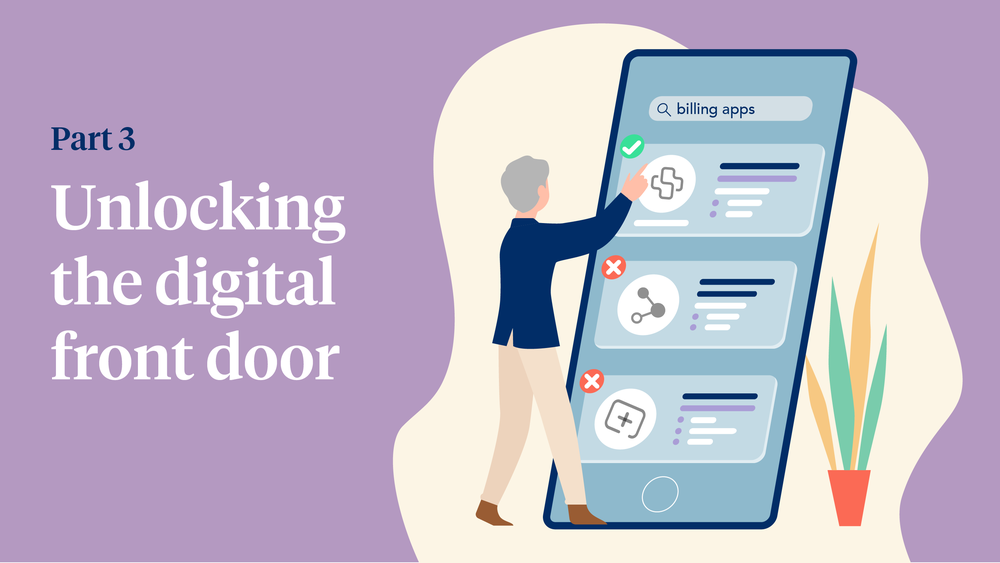Unlocking the Digital Front Door is a three-part blog series that explores how health systems can deliver meaningful digital patient experiences by choosing the right third-party solutions to optimize patient portal engagement. Read parts one and two now.
In the post-pandemic world, patients are accessing healthcare and engaging with providers in ways that seemed far-fetched only months ago. In-person is out, virtual is in and digital front door strategies have never been so crucial.
While living rooms will never fully replace exam rooms, there is a heightened sense of urgency around minimizing avoidable physical interaction and facilitating contactless engagement. As a result, health systems are accelerating their innovation roadmaps and looking for new ways to digitize patient touchpoints.
But with so many options available within and across various product categories, how can you ever be certain that you’re choosing the right technology partners to give your patients the best possible digital experience while balancing cost and operational requirements?
In truth, it’s hard to discern the real benefits and possible pitfalls associated with specific vendors before contracts are signed. And given that many health systems operate on razor-thin margins in the best of times, the risks associated with adopting a suboptimal solution are too big to ignore.
But within each digital health category are best-in-breed solutions that can help you advance progress toward your digital front door objectives. To ensure that you’re identifying and selecting the right third-party apps for your health system, you should be asking the following five questions (in addition to those listed in your standard procurement questionnaires) of every digital health solution early in the purchasing process:
1) What am I gaining beyond the product feature set?
Feature checklists have long been a useful tool in enterprise sales because they offer an objective overview of product functionality and allow you to easily compare and contrast alternatives. However, when you’re primarily evaluating products based on feature sets, you fail to capture intangibles such as usability and accessibility, which we know can have an outsized impact on patient engagement.
By pushing vendors to ditch the checklist, you can get a better sense as to how they go about developing their products as well as the extent to which they prioritize the patient experience. For example, that patient intake vendor that you’ve been considering might have every single feature that you’ve dreamed up and more. But if it takes the user nine minutes to get to the check-in page when it should only take four, are the bells and whistles really worth it? Unlike your existing patient portal, will that solution help you achieve your goal of streamlining financial clearance and reducing wait times?
Identifying the digital health partners that are truly user-obsessed will ultimately enable you to roll-out solutions that actually get adopted and used by patients.
2) How do you make the digital experience feel seamless for patients?
A common criticism of the “hub and spoke” digital health app model is that the patient experience feels disjointed and fragmented. A fair point; nobody wants to use multiple apps to schedule an appointment, confirm their upcoming visit, complete their registration paperwork, and pay their bills. However, in the absence of having that all-in-one app that does all things well, there are measures that forward-thinking vendors take to help the patient experience feel more cohesive.
When patients must interact with multiple interfaces, there should be minimal friction that gets in the way of achieving their goals. For instance, let’s say you want to position your patient portal as a centralized digital access hub but are looking to supplement its virtual visit capability with a third-party app. Vendors in your consideration set should be proactively thinking about how they can complement your existing patient workflows to ensure the most seamless experience for the end user.
Solutions such as embedding telehealth pages as iFrames within your patient portal UI or enabling single sign-on for external links are examples of common but resource-intensive fixes that can easily derail go-live plans if not properly scoped. In addition to affecting implementation timelines, vendors that aren’t proactively thinking about these aspects are clearly not prioritizing the needs of patients.
3) In plain English, how do you personalize the patient experience?
Like any industry, healthcare is fraught with buzzwords. Artificial intelligence, machine learning, predictive analytics—you’ve likely heard these terms in sales pitches (or seen them plastered across websites) but maybe have been unsure as to their actual application. Before you take a leap of faith and invest in that black box that supposedly personalizes the patient experience, try to dig deeper to understand how it works.
Start with the inputs: which data drive the analytics and why? By asking this, you’ll gain insight into the attributes vendors use to segment patients and get a better sense of the level of depth of their analysis.
For example, if a patient billing vendor says they use propensity to pay modeling to determine the most appropriate patient engagement strategy, don’t just take it at face value; probe on how they calculate p2p scores. Are they incorporating datasets beyond the EHR, such as publicly-available census and real estate databases, to fine tune their p2p models? If not, have they even explored the predictive power of these data?
It’s also important to understand how they optimize their personalization strategies to mitigate risk, because in healthcare, the stakes are always high. If vendors say they personalize billing outreach, are they constantly trying to strike the right balance between financial performance and patient satisfaction? Do their algorithms dynamically account for external events, such as the coronavirus pandemic, and shift engagement strategies in real-time?
By uncovering the answers to some of these questions, you’ll be able to differentiate between the solutions that are actually smart and those that hide behind smoke and mirrors.
4) What does the implementation lift look like for me, for you and for real?
While implementations have certainly become more streamlined in recent years through APIs and third-party app ecosystems, EHR integration and data interoperability continue to be a major challenge for providers and digital health vendors alike. The reality is given the bespoke nature of healthcare IT systems as well as that of health system workflows and processes, implementations are rarely painless and take time to get right.
So how do you gauge a vendor’s implementation prowess? Experience integrating with your EHR is definitely a plus, and seeing the app listed in your EHR vendor’s app store is even better. But it’s also important to listen with discernment when vendors discuss implementations during the procurement process.
If the discussion is too focused on the number of weeks or months until go-live, a vendor may prioritize speed over quality. In the long run, you want an implementation that is dependable and done right the first time around. You also want to get a good sense of what the technical lift looks like for your team. Your IT teams are undoubtedly strapped for capacity, and anything you can do to lighten their load goes a long way in helping your organization prioritize project backlog and achieve digital transformation objectives.
5) What will I get tomorrow by investing in you today?
When you spend time and resources vetting vendors, teasing out their differentiators and pulling in stakeholders from across your organization to participate in the decision-making process, you want to make sure that you’re purchasing a solution that’s future-proof. The bets that you’re placing today are more on a vision and team and less on any one product, and you really need to be 100% bought into where the vendor of choice is headed.
Instinctively you may request a presentation of their product roadmap; don’t do it! The minute a vendor starts talking about their roadmap it becomes obsolete; it’s only a matter of time before factors such as resource capacity, budget, external events and competitive pressures shift product priorities. Instead of focusing on specific features and development timelines, prioritize value. Understand the problems that vendors are trying to solve tomorrow and evaluate their vision on the basis on how relevant these problems are to your health system.
If a technology partner is not going to continuously be finding new ways of enabling value for your organization, then they’re probably not the best fit.
You have the keys, now open the door wide
For years “digital front door” was just another buzz phrase, a catchall term that highlighted the gaps between consumer expectations and healthcare’s digital capabilities. But what was once a nice-to-have is now becoming a public health imperative. In the very near team, digital front door initiatives will gain board-level awareness and as a result, budgets and go-live expectations will shift accordingly.
By now you understand the shortcomings of patient portals, benefits of using third-party digital health solutions and key evaluation criteria to separate good from great. Your patients deserve the best; give them the right digital tools to become active participants in their care, because when you do, everybody wins.



